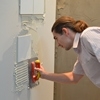Water absorption is a parameter that measures the porosity of ceramic tiles. A high water absorption coefficient indicates that the structure of the tile is porous, and a low coefficient indicates that the structure of the material is more dense. As a rule, low water absorption values correspond to higher strength characteristics of the tile (surface hardness, bending strength, abrasion resistance, frost resistance) and, as a result, affect the scope and operating conditions of the material.
Tile water absorption is measured by the amount of water that a ceramic tile absorbs under certain laboratory conditions and is expressed as a percentage of the dry weight of the tile. According to the European standard EN ISO 10545-3, the penetration of water into the open pores of samples is determined using two methods: boiling and water saturation in a vacuum. When boiling, water saturation occurs only in easily filled open pores; with the vacuum method, almost all open pores are filled. The boiling method is used to classify ceramic tiles or slabs, as well as to specify products. The vacuum method is used to determine open porosity, apparent density and bulk density, as well as water absorption. The essence of the test is that dry ceramic tiles are saturated with water and then immersed in water. Before testing, the samples are dried at a temperature of 110±5 °C in a special oven to constant weight, that is, until the difference in mass after two consecutive weighings within a 24-hour interval is less than 0.1%. The tiles are then allowed to cool to room temperature in a desiccator using silica gel or another suitable drying agent rather than acid. Each ceramic tile is then weighed to a certain level of precision, the results are recorded, and further testing is carried out.
Boiling method
Ceramic tiles are placed vertically in a container, so that they do not touch each other, and are surrounded by a layer of water five centimeters thick. The level of this layer is maintained throughout the test. The water with the samples is brought to a boil and the boiling process is maintained for two hours. Then the heating stops and the tiles cool to room temperature. For cooling, room temperature water or cooling heating elements are sometimes used. Then use a soft, damp suede cloth to dry the surfaces of the tiles. Profile surfaces are also tamponed with a suede cloth. Immediately after this treatment, each ceramic tile is weighed in the same way as when dry.
Vacuum method
The ceramic tiles are placed in a vacuum chamber so that they do not touch each other. Then the pressure in the chamber is reduced, a vacuum of 10 ± 1 kPa is created and maintained for half an hour. After this, with a vacuum created, the vacuum chamber begins to be filled with water until the tiles are covered with a layer of water of five centimeters. The chamber is then exposed to the atmosphere, and the tiles are kept under water for the next fifteen minutes. After which the tiles are removed, dried with a suede cloth and immediately weighed in the same way as in a dry state.
The ratio of the masses of ceramic tiles in a dry and water-saturated state allows you to calculate water absorption using the formula:
Water absorption (E): E (b/v) = 100 × (M 2 (b/v) – M 1 ) / M 1
where b / v – test method: boiling or saturation in vacuum, respectively;
M 1 - mass of dry ceramic tiles;
M 2 - mass of ceramic tiles saturated with water;
As mentioned earlier, porosity affects the physical and chemical properties of the material. This is why European standards use water absorption as a parameter for classifying ceramic tiles (for example EN 14411 ). When choosing a tile, you should remember that the lower the degree of water absorption, the more resistant it will be to intense mechanical and hydrothermal influences.
There are 2 Comments
Classification of ceramic tiles and slabs by water absorption
Based on water absorption, ceramic tiles and slabs are divided into the following three groups:
- ceramic tiles and slabs with low water absorption (group I), E < 3%;
- ceramic tiles and slabs with average water absorption (group II), 3% < E < 10%;
- ceramic tiles and slabs with high water absorption (group III), E > 10%.
In group I there is an additional division: E < 0.5%;
0.5% < E < 3%. In group II there is an additional division of 3% < E < 6%; 6% < E < 10%.
- Login to leave comments
note
The water absorption rate refers to the shard, that is, to the mass of the tile as a whole, and not to the surface. Therefore, in the case of glazed products, this characteristic does not affect the glaze, which, being a glassy waterproof coating, is devoid of porosity.
- Login to leave comments


